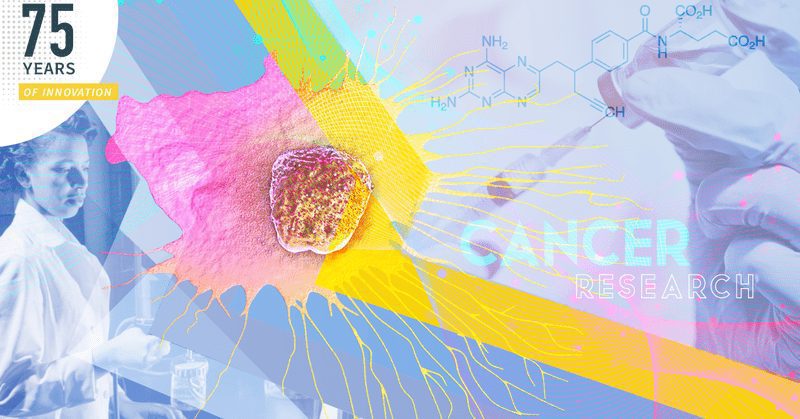The 75 Years of Innovation series highlights the groundbreaking innovations spanning from SRI’s founding in 1946 to today. Each week, SRI will release an innovation, leading up to its 75th anniversary in November 2021.

Innovations in treatments and mechanism of treatment delivery in the fight against cancer
How SRI International has helped in the battle against cancer
In 2018, there were 18 million cases of cancer across the world. By 2040, that figure is expected to be 27.5 million. Cancer is simply an awful disease that affects us all, either as sufferers ourselves or as supporters of loved ones with the disease.
Since the 1950s, new therapies have made cancer a more survivable illness with many cancers now having significantly improved 5-year survival rates.
SRI International, since the 1950s and continuing to the present-day, has made significant innovations in the development of cancer treatment. This post looks at just a few of the ground-breaking discoveries in the battle against cancer from the folks at SRI.
A few of the SRI’s projects that have focused on cancer
1960: Vidarabine
The isolation of two nucleosides from a marine sponge found in the Caribbean led to the synthesis of vidarabine at the Bernard Randall Baker lab at SRI International in 1960. Vidarabine works by inhibiting the synthesis of viral DNA. This mechanism can be used in the inhibition of DNA replication in tumor cells. Sometimes, drugs meant for diseases such as cancer also offer hope in combating other diseases. This is the case of Vidarabine. This treatment has been used in a variety of other illnesses including hemorrhagic cystitis, chickenpox and shingles. Vidarabine was the first antiviral agent licensed for systemic treatment, back in 1977.
1986: Tirapazamine
Tirapazamine, or to give it its full name, 3-amino-1,2,4-benzotriazine-1,4 dioxide, was developed in 1986 by SRI International in collaboration with researchers from Stanford Cancer Institute (SCI). This experimental drug was novel as it worked at the low levels of oxygen typically found in tumor cells (tumor hypoxia). The team at SRI and SCI went on to create the SRI Biosciences-Stanford Drug Discovery and Development Program, established in 2015. This program brought the expertise of the two groups together to develop new ways of treating cancer and other conditions.
1999: Targretin® (Bexarotene)
In 1999, the FDA approved the use of Targretin® to treat cutaneous T-cell lymphoma. This is a rare disorder of the immune system where T-cells, a type of white blood cell that fights infections, become cancerous and affect the skin and blood. Targretin® is a type of compound known as a retinoid; vitamin A is a type of retinoid. Targretin® works by slowing cell growth.
The 2000s: Pralatrexate
Pralatrexate is used in the treatment of peripheral T-cell lymphoma (PTCL). The drug was developed in collaboration with Memorial Sloan-Kettering Cancer Center, and Southern Research Institute and further developed on license by Allos Therapeutics in 2002. This class of drug had a long history of development at SRI and forms part of SRI’s deep commitment to innovation in cancer treatment. In an article at the time of the FDA approval, some notes on the importance of the collaboration and history of development were made:
“We are pleased that our long-term medicinal chemistry program in the area of antifolate therapeutic agents has resulted in development of a clinically effective drug for treatment of certain types of human cancer,” “This was achieved through SRI’s long-standing collaboration with the chemistry and molecular therapeutics investigators at Southern Research Institute and Memorial Sloan-Kettering Cancer Center.” — Joseph DeGraw, Ph.D., and William Colwell, Ph.D., both formerly of SRI International.
SRI, the here and now, and cancer
SRI continues to innovate in the area of cancer treatments. With a focus on early detection of the biomarkers of various cancers and the identification of novel cancer vaccines and immunotherapies, SRI has developed a cancer battle toolkit. Some more recent examples of SRI’s work in the area include:
Angiogenesis inhibitor, SR16388
SR16388 is a novel steroidal compound that acts as an angiogenesis inhibitor. SR16388 development was based on previous work over several decades into the inhibition of this process in various cancers. SR16388 provides binding affinity to estrogen receptor-α (ER-α) and -β (ER-β). It was trialed as a treatment for the inhibition of angiogenesis in lung and prostate cancers. It acts by inhibiting the development of new blood vessels that supply oxygen and nutrients to multiplying cancer cells.
FOX Three Molecular Guidance System and Cancer
Some therapeutic compounds are too large to enter tumor cells. This makes the targets inside the cells “undruggable”. SRI’s FOX Three Molecular Guidance System was designed to overcome these inherent size barriers in cellular systems. SRI has used this system to develop new immunotherapy “Targeted Antigen Loaded Liposomes” (TALL). TALL has demonstrated a potential to help the 80% of cancer patients who don’t respond to checkpoint inhibitors (CKIs), the leading category of cancer immunotherapies.
A hopeful future for cancer treatments
Cancer continues to present challenges on both an individual and a medicinal level. As our understanding of the complex biochemical pathways that underpin many cancers improves, the future of cancer treatment looks hopeful. Targeted treatments like those helped using the Synthetic Lethals Platform and the FOX Three Molecular Guidance System offer this hope in the form of precision and personalized medicine. Highly targeted therapies provide not only hope for a cure but also the potential of less intrusive and severe medication.
Resources
Cancer Research UK, Worldwide Cancer Statistics: https://www.cancerresearchuk.org/health-professional/cancer-statistics/worldwide-cancer#heading-Zero
Our World in Data, Cancer: https://ourworldindata.org/cancer#cancer-death-rates-are-falling-five-year-survival-rates-are-rising
SR-4233: A new bioreductive agent with high selective toxicity for hypoxic mammalian cells
Zeman, Elaine M. et al. International Journal of Radiation Oncology, Biology, Physics, Volume 12, Issue 7, 1239–1242
SRI Biosciences and Stanford Cancer Institute Launch Drug Discovery Program: https://www.prnewswire.com/news-releases/sri-biosciences-and-stanford-cancer-institute-launch-drug-discovery-program-300189442.html
FDA Approves Pralatrexate For Treatment Of Peripheral T-Cell Lymphoma: https://www.pharmaceuticalonline.com/doc/fda-approves-pralatrexate-for-treatment-of-0001
The Dish, What if you gave cancer the measles? https://medium.com/dish/what-if-you-gave-cancer-the-measles-a54ccef0304


